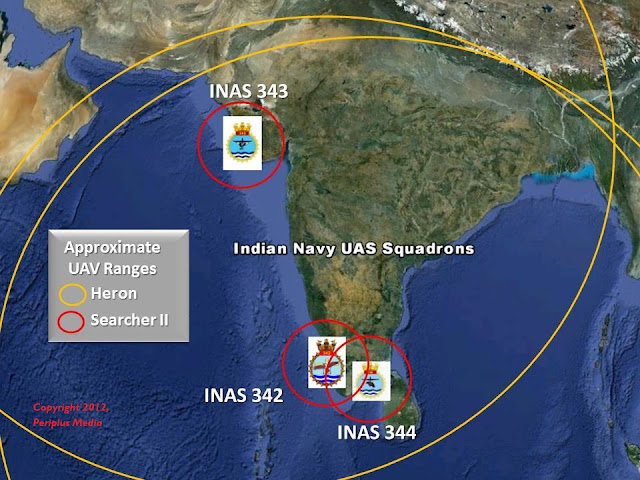India’s Growing Unmanned Naval Fleet
India
has one of the world’s largest Navies, with bluewater responsibilities and more
than 7,500 kilometers of coastlines and hundreds of islands to patrol. Besides the ever-present concern of Pakistan
and China looming to the east, the Navy keeps busy supporting international
counter-piracy efforts and protecting her coastlines from terrorist operatives
such as LeT, who infiltrated via the sea to attack Mumbai in 2008.
With a 2012 budget just shy of $6.5 billion USD, the Navy makes up only 20% of India’s overall defense expenditures. Nevertheless, unmanned systems appear to be an important component of the Navy’s ongoing modernization efforts to upgrade and from outdated Soviet-era platforms. India’s Navy reportedly has over 100 Unmanned Aerial Vehicles (UAVs) flying since 2003 and deployed with three squadrons. These aircraft will complement twelve manned P-8I Neptune maritime patrol aircraft entering service in 2013. Earlier this year, some of these UAVs participated in TROPEX, India’s largest annual naval exercise.
India Naval Air UAV Squadrons
The extent of India’s employment of sea-launched UAVs is unclear, although according to Schiebel, the Navy has conducted trials with the S-100. In 2008, India began joint development on IAI's Malat Naval Rotary UAV (NRUAV) system for the Chetak (Alouette III). The NRUAV replaces a manned helicopter's avionics with the flight control system from IAI's Heron UAV. The NRUAV is designed to carry a variety of ISR payloads including SAR, EO, and SIGINT. The system would be capable of missions 6 hours in duration at a range of 120 km from the launching ship. More UAV’s based at sea can be expected given India’s progressing indigenous Aircraft Carrier program. India’s Coast Guard, which is responsible for protecting the country’s two million square kilometer Exclusive Economic Zone, has reportedly acquired several indigenous Nishant catapult-launched tactical UAVs.
With a 2012 budget just shy of $6.5 billion USD, the Navy makes up only 20% of India’s overall defense expenditures. Nevertheless, unmanned systems appear to be an important component of the Navy’s ongoing modernization efforts to upgrade and from outdated Soviet-era platforms. India’s Navy reportedly has over 100 Unmanned Aerial Vehicles (UAVs) flying since 2003 and deployed with three squadrons. These aircraft will complement twelve manned P-8I Neptune maritime patrol aircraft entering service in 2013. Earlier this year, some of these UAVs participated in TROPEX, India’s largest annual naval exercise.
India Naval Air UAV Squadrons
Squadron
|
Commissioning
|
Base
|
Aircraft
|
INAS 342
– “Flying Sentinels”
|
2006
|
INS Kochi
|
Heron and
Searcher II
|
INAS 343 – “Frontier
Formidables”
|
2011
|
Porbandar,
Gujarat
|
Heron and
Searcher II
|
INAS 344 – “Spirited
Shadowers”
|
2012
|
INS Parundu, Uchipuli,
Tamil Nadu
|
Heron and Searcher
II
|
The
capital drones of India’s fleet are the Israeli Aircraft Industries (IAI) Heron
medium-altitude long-endurance (MALE) UAV equipped with radar and
electro-optical sensors for maritime surveillance. The Herons are complemented by smaller IAI
Searcher II UAVs, one of which crashed in Eastern India in February 2012 while
reportedly conducting surveillance against Naxalite insurgents. The navy is also
part of the joint development of the Rostom UAV, first flown in 2010, which is
expected to feature an armed variant.
The extent of India’s employment of sea-launched UAVs is unclear, although according to Schiebel, the Navy has conducted trials with the S-100. In 2008, India began joint development on IAI's Malat Naval Rotary UAV (NRUAV) system for the Chetak (Alouette III). The NRUAV replaces a manned helicopter's avionics with the flight control system from IAI's Heron UAV. The NRUAV is designed to carry a variety of ISR payloads including SAR, EO, and SIGINT. The system would be capable of missions 6 hours in duration at a range of 120 km from the launching ship. More UAV’s based at sea can be expected given India’s progressing indigenous Aircraft Carrier program. India’s Coast Guard, which is responsible for protecting the country’s two million square kilometer Exclusive Economic Zone, has reportedly acquired several indigenous Nishant catapult-launched tactical UAVs.
 |
| Photo Courtesy CMERI |
India’s
foray into unmanned naval systems isn’t limited to aircraft. The 490 kg Autonomous Undersea Vehicle 150 (AUV-150)
was developed by Central Mechanical Engineering Research Institute (CMERI), in Durgapur and conducted
sea trials in early 2011 off Chennai.
The AUV is designed to collect oceanographic data down to 150 meters,
along with supporting mine countermeasures operations, cable, and pipeline
surveys.
In April
2012, sport-utility vehicle maker Mahindra & Mahindra announced a
joint venture with Israel’s Rafael, maker of the Protector UAV, to produce
unmanned surface vehicles for force protection at a factory in Pune. Clearly,
unmanned platforms are destined to play an increasing role for India’s burgeoning global
fleet.

Wow that was odd. I just wrote ann extremely long comment but
ReplyDeleteafter I clicked submit my comment didn't appear. Grrrr...
well I'm not writing all that over again. Regardless, just wanted to say wonderful blog!
My web blog; car news los angeles - -